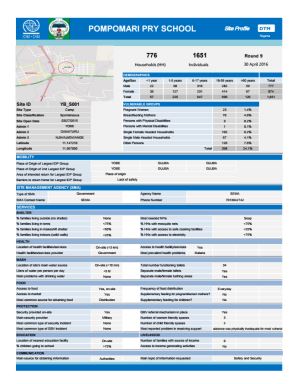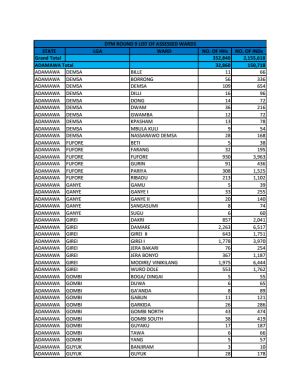-
Countries
-
Data and Analysis
-
Special Focus
-
Crisis Responses
Nigeria
Nigeria
Suivi des PDI
Mouvements de déplacement
3,340,000
IDMC 2023
cycle de collecte de données
À propos Nigeria
The escalation of violence between all parties in north-eastern Nigeria since 2014 has resulted in mass displacement and deprivation in the states of Adamawa, Bauchi, Borno, Gombe, Taraba and Yobe. To better understand the scope of displacement and assess the needs of affected populations, IOM has been implementing its Displacement Tracking Matrix (DTM) programme starting July 2014, in collaboration with the National Emergency Management Agency (NEMA) and State Emergency Management Agencies (SEMAs). The activities of the DTM project, which consist of conducting baseline assessments and registration for IDPs living in camps and host communities, are currently being carried out in Adamawa, Bauchi, Borno, Gombe, Taraba and Yobe.
The information collected will contribute to the provision of a comprehensive profile of the IDP population in Nigeria which will be shared with all relevant stakeholders and will contribute towards enabling the government of Nigeria and humanitarian partners identify the needs of Nigeria's displaced population and develop interventions for providing IDPs necessary assistance.
Contacter
DTM Nigeria
DTMNigeria@iom.int
Bailleurs de fonds
- ECHO
- BHA
- Canada
Nigeria — Federal Capital Territory Site Profiles 9 (1 March 2016—30 April 2016)
This document contains the site profiles for all displacement sites identified in the Federal Capital Territory, Nigeria.
Nigeria — Benue Site Profiles 9 (1 March 2016—30 April 2016)
This document contains the site profiles for all displacement sites identified in Benue state, Nigeria.
Nigeria — Yobe Site Profiles 9 (1 March — 30 April 2016)
This document contains the site profiles for all displacement sites identified in Yobe state, Nigeria.
Nigeria — Taraba Site Profiles 9 (1 March — 30 April 2016)
This document contains the site profiles for all displacement sites identified in Taraba state, Nigeria
Nigeria — Borno Site Profiles 9 (1 March 2016—30 April 2016)
This document contains the site profiles for all displacement sites identified in Borno state, Nigeria.
Nigeria — Adamawa Site Profiles 9 (1 March — 30 April 2016)
This document contains the site profiles for all displacement sites identified in Adamawa state, Nigeria.
Nigeria — List of Wards Assessed 9 (1 March — 30 April 2016)
This document lists all the wards assessed in DTM Round 9 by state, Local Government Area and ward, showing the total number of displaced individuals and households identified.
Nigeria — List of Displacement Sites Assessed 9 (1 March — 30 April 2016)
This document lists all the sites assessed in DTM Round 9 including the site ID, site name, state, Local Government Area, ward name, number of households and number of individuals.
Nigeria — Site Assessment Dashboard 9 (1 March — 30 April 2016)
200,085 IDPs in 33,441 households were identified in 97 displacement sites. 53% of the IDP population are children. The dashboard includes a map showing the location and population of sites by Local Government Area (LGA) assessed.
Nigeria — Displacement Dashboard 9 (1 March — 30 April 2016)
2,155,618 IDPs in 352,840 households were identified in Round 9 assessments from March to April 2016. 54% of the IDP population in the sites are children, 53% are female. The dashboard includes a map of displacement severity by Local Government Area (LGA) and ward.
Nigeria — Displacement Report 9 (1 March 2016—30 April 2016)
2,155,618 IDPs (352,840 households) were identified in Adamawa, Bauchi, Benue, Borno, Gombe, Taraba, Yobe, Nasarawa, Plateau, Kaduna, Kano, Zamfara states and Abuja. The highest number of IDPs are in Borno (1,427,999 IDPs), followed by Adamawa (150,718) and Adawama (134,415 IDPs).
Nigeria — Plateau State Site Profiles 8 (1 January — 28 February 2016)
This document contains the site profiles for all displacement sites identified in Plateau state, Nigeria.
Nigeria — Nasarawa Site Profiles 8 (1 January — 28 February 2016)
This document contains the site profiles for all displacement sites identified in Nasarawa state, Nigeria.
Nigeria — Kano Site Profiles 8 (1 January — 28 February 2016)
This document contains the site profile for the displacement site identified in Kano state, Nigeria.
Nigeria — Kaduna Site Profiles 8 (1 January — 28 February 2016)
This document contains the site profiles for all displacement sites identified in Kaduna state, Nigeria.
Nigeria — Federal Capital Territory Site Profiles 8 (1 January — 2 February 2016)
This document contains the site profiles for all displacement sites identified in the Federal Capital Territory, Nigeria.
Nigeria — Benue Site Profiles 8 (1 January — 28 February 2016)
This document contains the site profile for the displacement site identified in Benu, Nigeria.
Nigeria — Yobe Site Profiles 8 (1 January — 28 February 2016)
This document contains the site profiles for all displacement sites identified in Yobe state, Nigeria.
Nigeria — Taraba Site Profiles 8 (1 January — 28 February 2016)
This document contains the site profiles for all displacement sites identified in Taraba state, Nigeria.
Nigeria — Borno Site Profiles 8 (1 January — 28 February 2016)
This document contains the site profiles for all displacement sites identified in Borno state, Nigeria.
Nigeria — Adamawa Site Profiles 8 (1 January — 28 February 2016)
This document contains the site profiles for all displacement sites identified in Adamawa state, Nigeria.
Nigeria — List of Wards Assessed 8 (1 January — 28 February 2016)
This document lists all the wards assessed in DTM Round 8 by state, Local Government Area and ward, showing the total number of displaced individuals and households identified.
Nigeria — List of Displacement Sites Assessed 8 (1 January — 28 February 2016)
This document lists all the sites assessed in DTM Round 8 including the site ID, site name, state, Local Government Area, ward name, number of households and number of individuals.
Nigeria — Site Assessment Dashboard 8 (1 January — 28 February 2016)
186,268 IDPs in 34,240 households were identified in 84 displacement sites. 54% of the IDP population are children. The dashboard includes a map showing the location and population of sites by Local Government Area (LGA) assessed.
Pagination
Pagination
- First page
- Previous page
- 1
- 2
- 3
- 4
- 5
- 6
- 7
- 8
Pagination
- First page
- Previous page
- 1
- 2
- 3
- 4
- 5
- 6
- 7


























